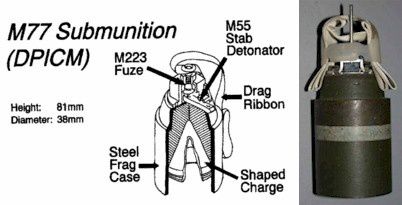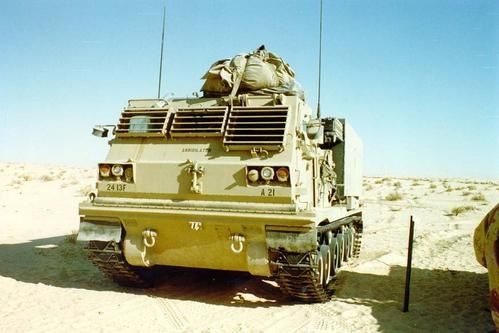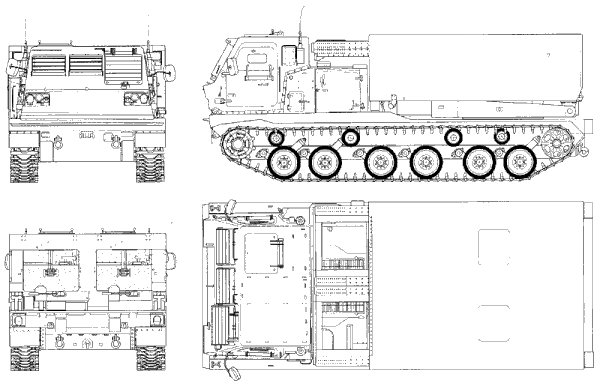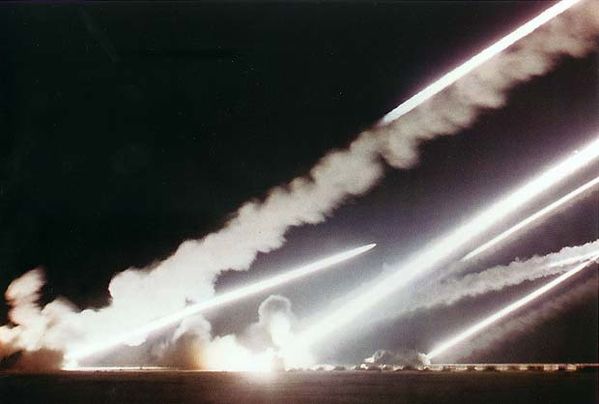


![]()


The MLRS M270 Launcher, a derivative of the Bradley Fighting Vehicle (BFV), is the standard U.S. Army platform for firing surface to surface artillery rockets and missiles. The Armored Vehicle Mounted Rocket Launcher (M270) is a full-tracked, self-propelled launcher/loader designed to launch 12 tactical rockets and re-deploy before enemy determination of launch position (shoot and scoot).
The launch platform is also used to launch the Army Tactical Missile System (Army TACMS) and is capable of launching all M270 Family of Munitions (MFOM) tactical rocket/missile variants. The launcher consists of six rockets, each of which are mounted and controlled in both azimuth and elevation. It has an automated control system for aiming that automatically corrects for launcher cant and ambient temperature, a directional reference system to obtain azimuth elevation and cant angles, and a FCS which is operated from a man-rated vehicle cab. The launcher platform structure provides a "self-loading" capability.
The M270 launcher has a maximum speed of 64 Km/hour, with a maximum range of 435 Km. It is capable of climbing a 60 degree slope and a one meter wall. Ordnance options include the MFOM (all variants of the MLRS rocket and Army TACMS missile). The M270 can load, arm, and fire a 12 rocket ripple within ripple within five minutes. M270 launchers are deployed three per battery and 29 per battalion. The M270 launcher can be configured for transport by Air Force C-141 aircraft on a limited basis. The M270 launcher is also transportable by Air Force C-5 and C-17 aircraft.
MLRS consists of a self-loading launcher with an onboard fire control system (FCS). The launcher is mounted on a mobile track vehicle that carries 12 rockets or 2 Army Tactical Missile System (Army TACMS) missiles, which can be fired individually or simultaneously. Rockets have a range beyond 30 kilometers, and the Army TACMS Block IA missile can reach to 300 kilometers.
The M270 MLRS, or SPLL (Self-Propelled, Loader/Launcher), is made up of two major units and an electronic fire control system (FCS). The SPLL is a mobile, self-propelled, self- loading, multiple launch rocket firing unit. It provides mobile long range artillery rocket support for ground forces. The M993 Carrier Vehicle and the M269 LLM are the two major units that make up the MLRS. The FCS is a computer control system, with a built-in computer and memory system. The SPLL has a cruising range of 300 miles at speeds up to 40 miles per hour. The total MLRS weights approximately 52,990 pounds.
The second multiyear procurement contract for FY89-93 was awarded in July 1989 for MLRS. The US initial operational capability for MLRS was achieved in 1983. Starting in FY89, MLRS has been coproduced by the United States, United Kingdom, Germany, France, and Italy. As of September 1995, a total of 857 launchers have been delivered, 772 to the active Army and 185 to the National Guard.
Deployment
In September 1997 the first US Army Command & Attack Battalion (CAB) Field Artillery (FA) unit was activated. This program previously known as the MLRS "2x9" fielded another MLRS firing battery and a Headquarters, Headquarters & Service (HHS) battery to the Division Artillery of the 1st Cavalry Division at Fort Hood, TX. This change merged these new batteries with the existing MLRS Battery, A Btry, 21st FA and the Target Acquisition Battery (TAB), B Battery, 26th FA. The new unit is now known as 1st Bn, 21st FA (1-21 FA).
This program will not be unique to 1st Cavalry Division. Over the upcoming years, fieldings will take place to all of the current "heavy" divisions within the active army. The direction to make this change was as a result of a decision made by the Vice-Chief of Staff of the Army on 29 Feb 96. The decision for this plan was put forward based on the Nov 93 release of the Legal Mix V Study with subsequent conclusions from the Army Science Board in Oct 95. The rationale was based on analysis that indicated the need for additional firepower within the division.
![]()


1st Cavalry Division Artillery (DIVARTY)
Headquarters and Headquarters Battery, 1st Cavalry Division Artillery, was constituted on 1 November 1940 in the Regular Army. It was then activated on 3 January 1941 at Fort Bliss, TX, for extensive field training. At this time, the 82nd Field Artillery Regiment was the only artillery unit assigned to the 1st Cavalry Division.
Throughout 1942, the 1st Cavalry Division Artillery underwent intensive training by honing its readiness to a fine edge.
Next, the 1st Cavalry Division Artillery wrote the first chapter of its history - The Admiralty Islands Campaign. This was followed by participation in the Leyte and Luzon Campaigns from 6 September 1945 to 1950. The Division Artillery performer occupation duty in Japan and girded itself for its next call to combat.
On 18 July 1950, the 1st Cavalry Division Artillery once again entered combat, this time in Korea. During the first few weeks, the Division's artillerymen found themselves fighting with small arms alongside their artillery pieces. The cannoneers of the 1st Cavalry Division Artillery continued to do their share in the fighting in Korea during 1950-1951.
In July 1965, the 1st Cavalry Division Artillery's colors were transferred to Fort Benning, GA, where it became part of the 1st Cavalry Division(Airmobile). The 1st Cavalry Division Artillery deployed to Vietnam in September 1965. Across all four Corps areas, as well as the incursion into Cambodia, the airmobile "Redlegs" checkmated the enemy at every turn.
In May 1971, the colors of the 1st Cavalry Division Artillery arrived at Fort Hood, TX.
In 1991, the Red Team helped pave the way for the1st Cavalry Division's charge into Iraq, while showering the enemy with over 9,00 cannon round and MLRS rockets. The artillery's lethal effects directly contributed to the success of the theater's deception plan. DIVARTY units were the first United States Army artillery units to fire cannon and copperhead rounds as well as MLRS rockets in combat during Desert Storm.
The 1st Cavalry Division Artillery deployed in support of the peacekeeping mission in Bosnia-Herzegovina in support of Operation Joint Forge.
On 30 June 2005, the 1st Cavalry Division Artillery (Div Arty) inactivated in ceremonies at Cooper Field on Fort Hood, Texas. The Div Arty has been part of the first Cavalry Division for the past 65 years. The inactivation was part of the division’s becoming modular.
The division had recently returned from Operation Iraqi Freedom II, serving as Task Force Baghdad. While in Iraq, the Div Arty Headquarters served as the division’s 5th Brigade Combat Team (BCT) and several FA battalions served as motorized task forces.
During his inactivation speech, the Commanding General of the 1st Cavalry Division, Major General Pete Chiarelli, praised the performance of the Div Arty in Iraq. “If you were to read each of [the Div Arty] Soldier’s records, you would not see infantryman written on them…. But on the streets of Baghdad, you couldn’t tell the difference. These were professional Soldiers with missions to accomplish, and they performed absolutely magnificently.”
Also during the 30 June ceremony, the 1st Battalion, 7th Cavalry (1-7 Cav) and 1-21 FA had changes of commands. Both battalions were part of the 5th BCT, among other units.

Operation Desert Storm 1991
![]()

MLRS M26 basic tactical rocket
SYSTEM DESCRIPTION:
The MLRS M26 basic tactical rocket was designed to complement cannon weapons in the tactical fires arena.
The M26 tactical rocket provides devastating effects in attacking critical, time sensitive targets with large volumes of firepower in a very short time. The M26 is a free flight unguided tactical rocket that provides an all
The M26 tactical rocket warhead contains 644 M77 dual purpose improved conventional munition submunitions which can be deployed to cover a 0.23 square km area. The average ground pattern of a 12-round ripple, with some overlapping of warhead patterns, varies from about 120,000 to 200,000 square meters, depending upon the range.
SYSTEM CHARACTERISTICS:
Six M26 rockets are loaded in the launch pod/container (LP/C) at the factory. The six M26 rockets are shipped, stored, and fired from the LP/C. The M26 rocket is a wooden round with a shelf life of at least 15 years. The M26 provides the firepower superiority needed to silence enemy artillery and critical targets. This awesome capability was termed "steel rain" by the Iraqi commanders duringDesert Storm.

.
![]()









![]()

| 857 systems Army ACAT IC Program | |
| Full-rate Production | 4QFY99 |
| Prime Contractor | Lockheed Martin Vought Systems |
| Crew | 3 man |
| Cruise Range | 483 km |
| On Board Fire Control and Position Determining System | |
| 12 Rockets; 644 M-77 Shaped Charges per Rocket | |
| Reload Time | 9 minutes |
| Rocket Range | 31.8 km |
| REFERENCES |
|

.

.
![]()






















/idata%2F0396584%2FKOREA%2F71910_korea_MIA1_800.JPG)
/idata%2F0396584%2FU.S.ARMY-POST-WW2%2Fphot4901a.jpg)
/idata%2F0396584%2FDRAWINGS-UNIFORMS-WW2%2F30-451-09b-2.jpg)
/idata%2F0396584%2FP-40%2F44FS000.jpg)
/idata%2F0396584%2FGERMAN-U-BOAT%2FBundesarchiv_Bild_101II-MW-1031-28-_Lorient-_U-31.jpg)
/idata%2F0396584%2FSOVIET-ARMY-WW2%2F1.jpg)




